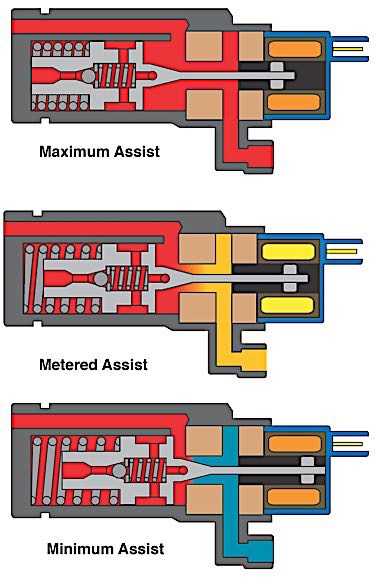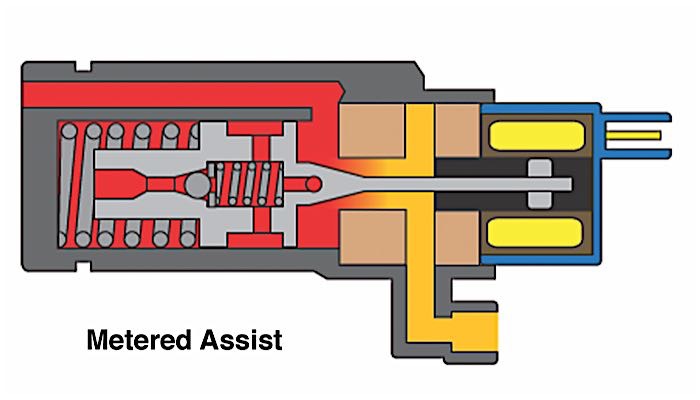 In the 1950s, the 20-inch-diameter steering wheel was standard on most vehicles. With a wheel this large, turning it required a certain amount of upper body strength. Most of these steering systems relied on mechanisms that provided an extra mechanical advantage to make it easier.
In the 1950s, the 20-inch-diameter steering wheel was standard on most vehicles. With a wheel this large, turning it required a certain amount of upper body strength. Most of these steering systems relied on mechanisms that provided an extra mechanical advantage to make it easier.
By the start of the 1960s, power steering was an option or standard on all American-built vehicles. The big steering wheel still graced steering columns until the 1970s, but the systems were growing more sensitive to inputs at high speeds. To reduce the input sensitivity, the diameter of the steering wheel was made smaller.
During the past 20 years, steering feel is one of the most researched and engineered aspects of any vehicle. To get the feel just right, OEMs are using a combination of old and new technologies that can also help to make the engine more efficient.
There are two types of conventional power steering systems. The first type uses a hydraulic cylinder attached to the drag link and the chassis. A control valve is attached to the end of the drag link replacing the tie rod end and the valve actuator is connected by a tapered shaft to the pitman arm.
The second type uses a hydraulic cylinder that is an integral part of the steering gear and is connected to the recirculating ball nut located on the steering shaft. The rotary control valve is connected to a torsion bar that is part of the steering shaft. The rack and pinion steering gear hydraulic cylinder is part of the rack gear, and the control valve is connected by a torsion bar to the steering shaft. In all these types of power steering systems, the pump delivers fluid to the control valve. The control valve opens a pressurized flow to and from the hydraulic cylinder.
The control valve responds directly to input from the pitman arm or steering shaft. The actuation of the control valve is based on input geared to slower vehicle speeds where assist is needed the most. This configuration makes the steering more sensitive at higher speeds.
In the 1990s, modifying the flow from the pump to the cylinder was the preferred method to reduce high-speed sensitivity. This control system is called an Electronic Variable Orifice (EVO). The EVO valve is mounted at the power steering pump outlet. The valve uses an electronic controller to produce magnetic field changes in the valve’s solenoid coil. The valve pin attached to the orifice valve extends into the solenoid coil. The magnetic field generated by the solenoid coil will pull the pin into the coil. This pulling action regulates the flow through the valve. The valve and controller can be used with both rack and pinion and conventional systems.
An electronic controller changes the magnetic field in the solenoid coil by sending a Pulse Width Modulated (PWM) voltage to the coil. The controller adjusts steering effort based on vehicle speed input to the controller and steering wheel position. Vehicle speed input normally comes from the Engine Control Module (ECM).
On some systems, the steering wheel position comes from the Hand Wheel Speed Sensor (HWSS). It measures the speed at which the steering wheel is being turned and produces a variable analog voltage signal to the controller. The signal will vary from a high voltage to a low voltage and return to high voltage as the steering wheel is turned through 180 degrees of rotation. A combination of vehicle speed and the rate at which the steering wheel is being turned will produce a PWM signal from the controller to the solenoid coil varying the amount of assist.
Failure Modes and Effects
What happens when the coil in the EVO valve fails? The power steering pump will deliver full pressure and volume to the hydraulic cylinder. Steering the vehicle will be more sensitive than when the valve was operating, and it will exist under all conditions.
What happens when the valve fails in the closed position? Steering the vehicle will require more effort, as there will be little or no assist. What happens when a sensor fails? When a sensor or input fails, it will most likely produce an intermittent failure. An intermittent interruption to the vehicle speed input to the controller will produce an increase in power assist. This condition can be detected when the vehicle is moving, as the steering wheel is sensitive to small inputs. The controller is then in parking mode with the pump delivering full steering assist.
An intermittent interruption of the HWSS with the vehicle moving will produce minimum power assist. This will be detected as a sudden increase in steering effort when the vehicle is turning a corner.














